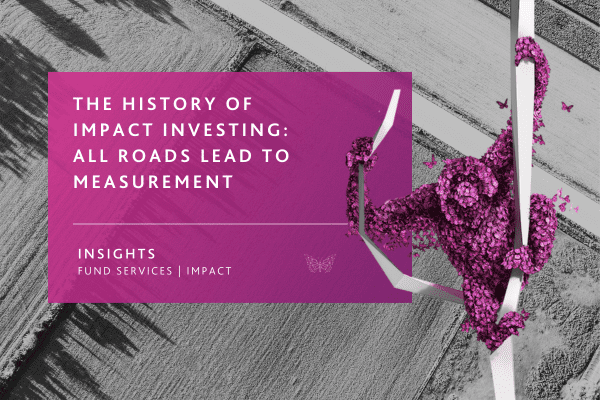Socially responsible investing is nothing new, but what makes it more effective than ever is the ability to quantify and compare impact.
For as long as there have been investments, there have been socially responsible investments (SRI), where the effect an industry has on the community is considered alongside profit.
Some ancient cultures essentially mandated them in 1500-1300 BC, while others forbid investment in such things as gambling, alcohol, and pork for moral or religious reasons. By the 18th century, certain religious sects were steering dollars away from the slave trade, and by 1928, the US had its first publicly-available investment vehicle – the Pioneer Fund – expressly designed to screen out so-called “sin” industries.
SRI really picked up steam in the 1960s and the decades that followed, at which point their history begins to collide with what we now think of as impact investing, wherein investors do not merely screen out bad investments, but make ones that serve social good and deliver market returns.
Recent years have seen the rise of ESG, or Environmental, Social, and Governance principles, a sector some have predicted to hit $53 trillion by 2025. ESG has become so all-encompassing that it now seems there are too many investments self-applying the ESG label and investors are wary of trusting companies’ ESG claims.
The vagueness of ESG definitions, concerns about greenwashing, and political battles over ESG have given rise to modern impact investing, which focuses on intentionality and specific measurable results over broad corporate initiatives. At the same time, a rise in ESG reporting requirements in Europe and proposed environmental reporting changes in the US have meant no one can afford to ignore the impact of their business activities.
Just how did we go from a solitary Pioneer Fund to a world where even funds and companies without a specific impact focus have to think seriously about how ESG will affect their reputations and ability to fundraise?
Numerous factors played a role, including generational differences and a rise in public consciousness of environmental and social issues, but part of the recent surge in impact investments, and their continuing popularity in spite of the controversy surrounding ESG, comes from an increased ability to measure and track the actual impact of a project. When investors can actually see the good their investments are doing, they’re more likely to invest in impact.
“What’s Measured Improves”
The groundwork of the modern impact investing market was laid by the social movements of the 1960s. Civil rights, women’s fight for equality, and the Vietnam War all served, as Steve Schueth notes, “to escalate sensitivity to issues of social responsibility and accountability.”
Towards the end of the decade, anti-war protestors demanded university endowments no longer invest in defense contractors, launching an SRI movement against “Agent Orange.” In the early 1970s, mutual funds sprouted up reflecting “faith-based values, civil rights-era sensibilities, and environmental concerns,” the last of which came to the fore as “protests over nuclear disarmament evolved into concerns over nuclear energy.”
By the time the 1980s rolled around, the SRI value proposition in major world markets had become relatively standardized and popularized; accordingly, more and more firms awoke to the importance of new concepts like corporate responsibility and shareholder engagement, which ultimately ushered in the ESG principles familiar to us today.
Many methodologies for measuring ESG success have emerged both internationally and domestically thanks to government regulation, nonprofit or academic ventures, and even investment firms themselves. As the industry evolved, so did its ability to report on impact so investors could understand the scope and success of ESG efforts.
For instance: Ceres, a coalition of environmental nonprofits, religious investors, and large asset managers, developed a set of ten sustainability principles for companies to (voluntarily) sign, setting the stage for the Global Reporting Initiative and disclosure frameworks developed by the Sustainable Accounting Standards Board.
New measurement models, such as the Global Impact Investing Network’s IRIS+ and Howard W. Buffett’s Impact Rate of Return, have continued to move the needle as the focus has shifted from inputs to outcomes, giving investors an ability to actually quantify what has been accomplished and compare investments with different impact goals.
The more information that is provided for investors, the more a fund will stand out in an increasingly crowded marketplace. In this way, transparency has become a true differentiator for ESG and impact-focused funds, something we at JTC know about firsthand.
JTC has been recognized as a model for ESG success due to the company’s shared ownership structure. Since 1998, every employee has been a direct stakeholder in the business, adding value by aligning our people directly with the interests of our clients and the business over the long term.
This truly sets JTC apart from other fund administrators and has created a ‘stronger together’ culture. In fact, JTC’s ownership model is so revolutionary that Harvard Business School included the firm in its 2019 MBA curriculum.
Our fund clients care that we walk the walk on ESG, and by working with JTC, they can show their investors that they take these issues seriously. We give impact funds the ability to properly measure the actual impact of investments, because it’s only through accurate measurement that we can evaluate success and take steps to improve our world.
To repeat the words of famed management consultant Peter Drucker: “What’s measured improves.”
A new era of impact measurement
As the ESG marketplace has continued to become more crowded, the term has also become highly politicized. Investors have to be concerned about greenwashing, investments that are ESG-focused in name only, and US politicians have seized on ESG because of the incorrect assumption that taking community stakeholders into account is bad for business.
The impact investing sector has distanced itself from ESG because it focuses on intention in order to measure and quantify impact. By catering to investors’ specific passions, funds not only offer investments that strive for the exact type of impact their investors are hoping to make, but can offer hard statistics of results.
It’s important to understand that all investments and business activities have an impact, regardless of intention. If a fund’s goal is to construct affordable housing, that doesn’t mean its only effect on society is through the construction of new affordable housing units. Hiring practices, sustainable construction, diversity in management, and affordable energy are all elements of ESG that must be considered by conscientious fund managers, but they aren’t the specific intention of the investment. The intention is to construct affordable housing, so investors need to see quantified results for this specific impact metric. Even if the property is sustainably built, this won’t satisfy investors unless they see proof that the promise of affordable housing was delivered upon.
As investors become savvier, they will expect more when it comes to impact reporting. In order to satisfy investor demand, comply with future government regulation, and stand out in a competitive fundraising environment, funds will have to offer more.
That’s where JTC comes in. Measuring impact can seem complicated, but doesn’t have to be. As a fund administrator, we work closely with a fund’s accounting processes and deal with a great deal of financial information which can then be used to track progress toward impact goals. Our impact reports take into account community metrics and stakeholders, are consistently updated, and utilize social impact metrics to report throughout a project’s life cycle, so investors know what progress has been made and the ultimate impact of an investment through in-depth impact reports.
Taking a look at the history of impact investing, we see people have always cared about where their dollars went, and now we live in a new era of information where they can select investments based on a fund manager’s impact track record and the specific intention of a project. In order to compete, funds will have to deliver real impact, and will have to prove it. With JTC’s purpose-built fund administration solution for impact funds, this information can be provided in greater detail than ever before.
Regardless of where impact investing has been in its past, it’s a fact that impact tracking and reporting will be an essential part of its future. Proper measurement catalyzes a virtuous cycle: by proving impact investing actually has an impact, we get more people involved, and the more people get involved, the more we impact we can create.
Stay Connected
Stay up to date with expert insights, latest updates and exclusive content.
Let’s Bring Your Vision to Life
From 2,300 employee owners to 14,000+ clients, our journey is marked by stability and success.



















